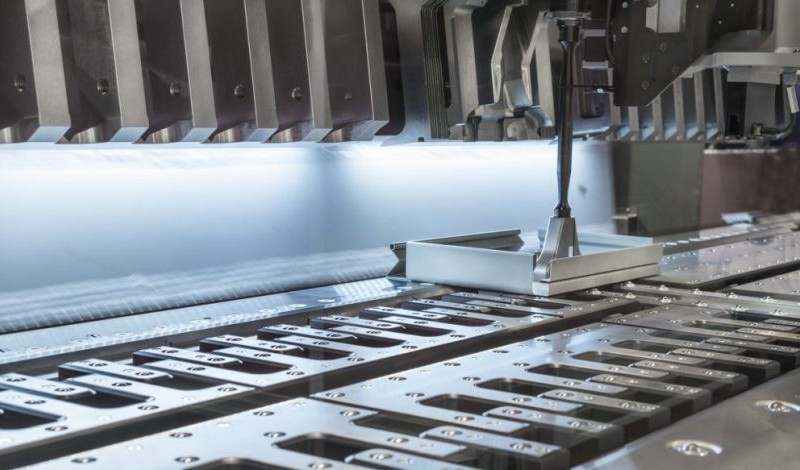The Evolution of Metal Stamping Innovation: A Comprehensive Introduction
The Evolution of Metal Stamping Innovation: A Comprehensive Introduction
Blog Article
Metal Marking Innovations: Elevating Production Processes for Superior Outcomes
In the world of manufacturing procedures, steel stamping has long been a foundation strategy for producing a variety of precision parts. With the unrelenting march of technological innovation, the landscape of metal stamping is undertaking a substantial change.
Development of Metal Marking Strategies

Additionally, innovations in product science have actually led to the growth of high-strength alloys that can now be seamlessly marked right into detailed shapes, accommodating a more comprehensive variety of commercial applications. The assimilation of robotics and man-made intelligence has actually additionally optimized the stamping process by improving rate and accuracy while lowering the danger of human mistake.

Effect of Advanced Materials
Have innovative products changed metal stamping processes substantially in the manufacturing sector? By utilizing materials such as high-strength alloys, advanced composites, and cutting-edge finishes, steel stamping procedures can now produce parts that are lighter, stronger, and more sturdy than ever previously.
These innovative products use premium mechanical residential properties, rust resistance, and thermal security, allowing manufacturers to meet the demands of contemporary industries such as aerospace, vehicle, and electronics. In addition, making use of advanced products in steel marking has helped with the production of intricate geometries and detailed layouts that were formerly unattainable with standard approaches.
Moreover, the implementation of advanced products has actually brought about decreased product waste, lower production expenses, and much shorter lead times, making metal stamping processes more affordable and lasting. As technology proceeds to development, the impact of advanced materials on metal marking procedures is expected to drive more technology and improve the competition of manufacturers in the international market.
Automation in Metal Stamping
The advancement of steel marking processes driven by the integration of advanced materials has established the phase for significant advancements in automation within the production industry. Automation in steel marking has revolutionized manufacturing processes, enhancing efficiency, accuracy, and overall result quality. Through the application of robotics, sensing units, and computer-controlled systems, jobs that were once manual and lengthy can now be executed with unparalleled rate and accuracy.
Automation in metal stamping not only increases production prices but likewise guarantees uniformity in the manufacturing process. By decreasing human treatment, the risk of mistakes is considerably minimized, bring about greater degrees of product uniformity and integrity. Additionally, automation enables makers to embark on intricate stamping jobs that would be impractical or difficult to attain manually.
Furthermore, automation in steel marking contributes to a much safer working setting by decreasing the requirement for staff members to engage in harmful or recurring jobs - Metal Stamping. This change in the direction of automation read this not only enhances efficiency but also leads the method for the future of manufacturing, where innovation plays a main function in driving functional quality
High Quality Control and Evaluation Equipments
With a concentrate on accuracy and reliability, top quality control and assessment systems play a vital role in making sure product quality in metal stamping procedures. These systems are developed to keep an eye on every stage of production, from product inspection to the end product, to assure that all elements satisfy the required criteria. By carrying out innovative innovations such as optical assessment systems, coordinate measuring machines (CMM), and automated assessing tools, producers can identify even the tiniest discrepancies in dimensions, surface high quality, and general honesty of stamped components.

Sustainability Practices in Steel Stamping
Building upon the structure of precision and dependability developed through top quality control and examination systems, the integration of sustainable methods in metal marking procedures is increasingly ending up being a prime focus for manufacturers seeking to reduce ecological impact and enhance resource use. Sustainability practices in metal stamping incorporate a variety of efforts focused on decreasing waste generation, energy intake, and greenhouse gas exhausts throughout the manufacturing process.
One key facet of sustainability in metal stamping is the adoption of eco-friendly products and technologies that advertise recyclability and waste decrease. By utilizing recycled products and carrying out energy-efficient equipment, makers can decrease their carbon footprint and add to a much more lasting manufacturing cycle. Furthermore, maximizing manufacturing processes to decrease product waste and energy use not just benefits the setting yet likewise causes set you back financial savings for businesses in the future.
In addition, the execution of lasting practices in metal marking can boost brand track record and appeal to eco aware consumers. As sustainability proceeds to obtain importance in the manufacturing sector, integrating green campaigns into steel stamping procedures is essential for long-lasting success and competition in the market.
Verdict
Finally, look at this web-site steel marking techniques have substantially advanced over time, integrating sophisticated materials and automation to boost making procedures. Quality control and inspection systems play an important duty in making sure premium outcomes, while sustainability practices are progressively being applied to lower ecological effect. These advancements in steel marking have revolutionized the sector, causing extra reliable and sustainable manufacturing techniques for various industries.
Steel stamping, as soon as a manual and labor-intensive procedure, has transformed into a highly automated and innovative technique of shaping metal sheets right into various kinds and styles.Have innovative products changed metal stamping processes significantly in the manufacturing sector? By utilizing materials such as high-strength alloys, advanced composites, and cutting-edge finishings, steel stamping procedures can currently generate components that are lighter, more powerful, and a lot more durable than ever previously.
The development of metal marking processes driven by the combination of innovative products has set the stage for significant improvements in automation within the production market.In final thought, steel stamping strategies have actually substantially developed over time, including advanced materials and automation to improve manufacturing processes.
Report this page